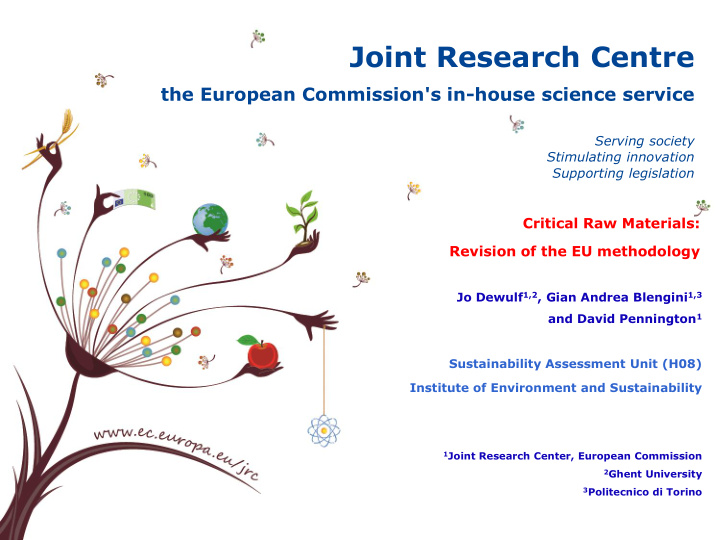



Joint Research Centre the European Commission's in-house science service Serving society Stimulating innovation Supporting legislation A modern JRC in a modern Commission Critical Raw Materials: Revision of the EU methodology Jo Dewulf 1,2 , Gian Andrea Blengini 1,3 and David Pennington 1 Vladimír Šucha , Sustainability Assessment Unit (H08) Director-General Institute of Environment and Sustainability 1 Joint Research Center, European Commission Ispra, 10 July 2015 2 Ghent University 3 Politecnico di Torino
Table of contents 1. Introduction 2. EU 2014 list of Critical Raw Materials 3. Criticality methodology 4. Supply risk influences and resilience 2
1. Introduction 3
The JRC inside the European Commission Joint Research Centre (JRC) is the European Commission's in-house science service and the only DG executing direct research Institute for Environment and Sustainability (IES) “The mission of the IES is to provide scientific-technical support to the European Union's policies for the protection and sustainable development of the European and global environment” 2
EU “Raw Materials Initiative”: • Aim: securing sustainable supply of raw materials • Launched in 2008, consolidated in 2011 • Non-energy, non-agricultural raw materials • Connecting EU external and internal policies • Integrated strategy (3 pillars) • Introduced list of Critical Raw Materials (CRMs) in 2011 and 2014 6
2. EU 2014 list of Critical Raw Materials 6
How to assess Critical Raw Materials? EU 2014 Economic Supply risk importance • Political and economic stability • Importance of a • Level of raw material per production economic sector concentration & importance of the sector in the • Potential for EU economy substitution • Recycling rate
Supply risk EU 2014 Source: Fraunhofer ISI. Supply risk = HHI x WGI x (1-R) x S 18
EU 2014 : 9
Context of EU 2014 list of Critical Raw Materials: - 2014 is a follow-up the 2010 list of Critical Raw Materials - As Criticality changes with time, updates foreseen every 3-4 years - Next: EU 2017 list of Critical Raw Materials Preparation of the EU 2017 list of Critical Raw Materials: - Review of methodology by DG GROW- DG JRC (end early 2016): - Supply risk and economic importance - Role of export restrictions and import dependency - Reliable data for assessing criticality - Additional influences on criticality - Biotic materials - Uses of the list of Critical Raw Materials - Improved methodology available to consultants in charge of EU 2017 list 9
3. Criticality methodology Some currently investigated potential adjustments 11
* Working definition of criticality: A Critical Raw Material is one with high risk of a supply disruption and, at the same time, with high economic importance. High risk of supply disruption means that supply might not be adequate to meet EU industry demand. High economic importance means that the raw material is fundamental in industry sectors to create added value and jobs, which are lost in case the raw material is not available and adequate substitutes cannot be used instead.
* Adjusting for export restrictions (trade barriers) - Abrupt increase of export restrictions in minerals and metals sectors worldwide since 2009 - Supply risk may increase by these export restrictions (country-specific)
* Country concentration of supply: need to be specific? -Global production versus specific supply: the example of Manganese Worldwide production US supply - 100% import dependent - Manganese ore: 72% Gabon - Ferromanganese: 67% South Africa, China, Brazil Source: EC, 2014 Source: NRC-US, 2008
* Concentration shifts along the supply chain “primary production” Manganese Mining stage Refining stage Source: EC, 2014
4. Supply risk influences and resilience - Other additional influences on supply risk? - byproduct dynamics - land use: economic competition, regulation … → no comprehensive structure - Supply risk disruption versus resilience to supply disruption 16
TERP Concept: - 4 groups of influences: - Tech/Phys/Geol. - Econ/Strategic/Market - Regulatory/Social - Political stability & Governance - 17 particular influences: 17
Influences on supply risk or on resilience to supply disruption? 18
Thank you! Jo Dewulf, European Commission,DG JRC, IES-H08 Sustainability Assessment European Platform on Life Cycle Assessment (EPLCA): http://eplca.jrc.ec.europa.eu/ Raw Material Information System (RMIS): http://rmis.jrc.ec.europa.eu/ Sustainability Assessment (H08): http://sa.jrc.ec.europa.eu/ JRC Science Hub: https://ec.europa.eu/jrc/
Recommend
More recommend